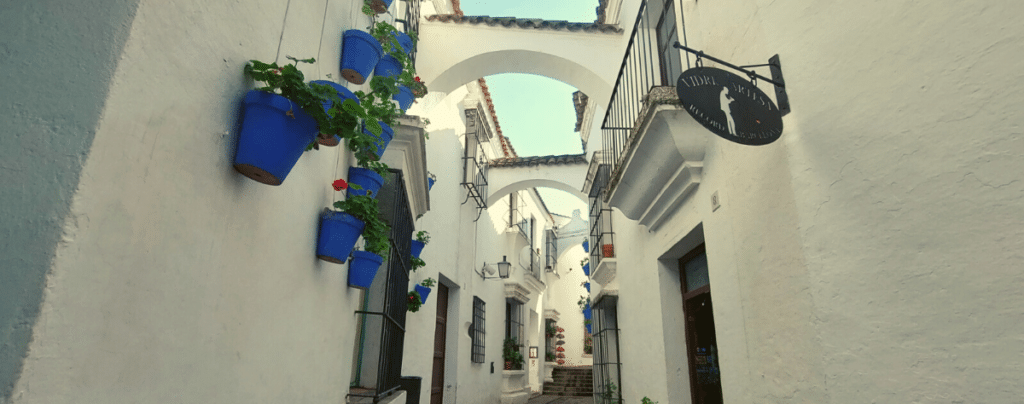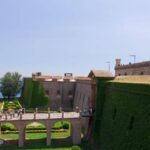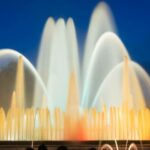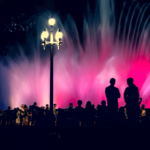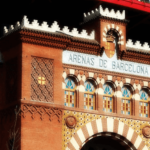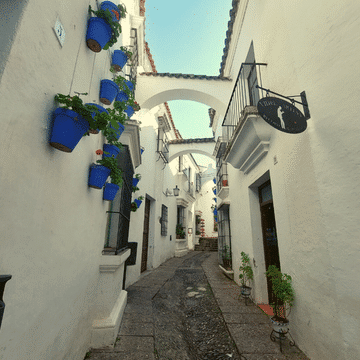
Visiting El Poble Espanyol de Montjuic
THE SPANISH VILLAGE IN BARCELONA
Poble Espanyol (in English Spanish Village, in Spanish Pueblo Español) is one of the top attractions of the Hill of Montjuic in Barcelona, and also one of the most versatile. Some may want to visit it for the scenic spots and fun instagramable photo opportunities. Other will go for the unique handcraft gifts and souvenirs that you can’t find anywhere else in town. Some will go for the flamenco show, or the nightlife, or the contemporary art. Or even the many events, festivals and family activities that are organized there regularly. What’s your reason to visit Pueblo Español?
History and concept of the Pueblo Español
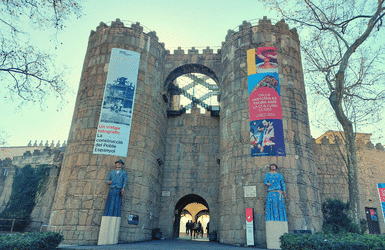
Barcelona celebrated its second World Fair in 1929. The first one had taken place in 1888 in the Ciutadella Park, and now it was the turn of the Montjuic Hill. It was a time when travel wasn't easy and the organizers decided to create an enclosure that could transport visitors around Spain in a short amount of time. It'd be a space shaped as a village: with its real-size buildings, its streets, its plazas... But where the buildings replicated the traditional styles and representative buildings of each region of Spain.
A small team of artists and intellectuals led by the painter Miguel Utrillo (member of the central core of modernist artists of Barcelona) were sent on a tour around the country, visiting over 1600 villages, towns and cities to gather ideas and chose the architectural elements that were worth including in the project. The result was conceived to look real, well integrated, and coherent. The buildings would be placed together considering its original location, style and materials, in a way that the transition from one to the other felt natural, even if that meant introducing changes in the final structure compared to the original.
The Spanish Village was meant to be an attraction built just for the World Fair, and then be demolished like most of the rest of the fair structures. However, the quality of the construction and its popularity led to saving it. After years of ups and downs, the Poble Espanyol has managed to define its personality as a cultural center and an outdoor museum with charm.
Best itinerary around the Poble Espanyol de Barcelona
1
Avila Walls
Like many Spanish medieval towns, the Pueblo Español is surrounded by a wall. And the access to the village is through an imposing gate that replicates the famous walls of the Town of Avila and specifically its Gate of Saint Vincent. In the 1980’s the towers next to the gate housed a very popular nightclub but nowadays they aren’t open to the public and you can only see its outside.
2
Plaça Major - the Main Square
To the left of it stands the town hall of the Pueblo Español itself: a building inspired in the town hall of Valderrobres (Aragon), but larger. This square, complete with bandstand, is where most of the concerts and festivals are celebrated.
3
The Galician area
To continue exploring the Spanish Village, head to the top left corner of the plaza. You are now entering the area dedicated to Galicia – the bit of the North of Spain on top of Portugal. This area is famous for the pilgrims that cross it via the Camino de Santiago hiking trail on their way to Santiago de Compostela, where the Apostle Saint James is buried. The staircase taking you to the next level of the village is actually inspired in the stairs of the Cathedral of Santiago – the actual Cathedral was too big to be replicated, but to achieve a continuity in the landscape, another church was place at the top of the stairs.
4
The Aragon square
And finally, the belltower belongs to a different church, the one of the village of Utebo – also made of brick and with more tile details than the mansion from Torralba de Ribota, but also in Mudejar style. By the way, the building attached to the Carmelites church houses an installation of the Catalan contemporary sculpture Josep Guinovart.
5
The Andalusian quarter
After leaving the Utebo bell tower behind, the brick mudejar architecture melts into white-washed streets: you are entering now the Andalusian Quarter – South of Spain. A bit hidden to the left you’ll find the replica of the Posada de las Animas from Ronda, an old inn where Miguel de Cervantes, author of the famous Quijote novel lived once.
The Posada of Poble Espanyol houses a hidden gem: the Fran Daurel Foundation – a private contemporary art museum displaying pieces by Spanish masters such as Picasso, Dali, Miro, Tapies, Chillida, Plensa, Barcelo, among others.
Continuing with the white-washed theme, you’ll now enter an arched alleyway inspired in the Calle Arcos from Arcos de la Frontera, one of the most famous “pueblos blancos” (white villages) of Andalusia. In this alley you’ll find one of the oldest flamenco venues in Barcelona: the Tablao de Carmen. Here performed the famous dancer Carmen Amaya, after whom the venue is named. TIP: If you book one of their daily flamenco shows, you’ll get free access to the Poble Espanyol up to 1 hour prior to the show.
The Andalusian quarter finishes in an atmospheric plaza with orange trees and a fountain, inspired in a corner of Cordoba, the city with the largest number of UNESCO sites in the world, and famous for its patios decorated with geranium pots.
6
Catalonia
In one end of the plaza there’s a gate opening into the walls that surround Poble Espanyol. Exit through the gate to find a path that leads uphill to a monastery that incorporates all the characteristics of the Catalan Romanesque from the Pyrenees. The church can actually be rented for weddings. And in a small fountain in front of it, on the day of Corpus Domini takes place the tradition of the L’Ou com balla (an egg that dances on top of the water jet).
Return back to the Catalan plaza and take now the street to the right that returns back to the entrance of the Spanish Village from a different path. Before you reach the Aragon Plaza again, you’ll see to the right another wall gate, inspired in the one of Montblanc – the town where Catalan believe that Saint George killed a dragon. The gate takes you to a garden displaying contemporary sculptures that belong to the collection of the Fran Daurel Foundation.
7
Northern Spain street
After leaving behind the Aragon plaza, the street transitions to the other side of the Pyrenees: the Basque Country, Navarra and Cantabria. The architecture incorporates more wood, balconies and two-slopes roofs. Right before reaching an arch there’s the reproduction of some pre-Romanesque engravings found in the hermitage of San Miguel Arcángel in Villatuerta. This street of Poble Espanyol features many bars and crafts shops and workshops.
8
The Center of Spain
El Poble Espanyol practical info
ADDRESS: Av. Marquès de Comillas, 13-27 (Barcelona, Spain)
WEBSITE: https://poble-espanyol.com/
SCHEDULE: Open every day of the year from 10AM.
Nightlife: There’s three night clubs inside the Pueblo Espanyol: Sala Upbeat (underground music), La Terrrazza (outdoor electronic music club open in the Summer) and Input (techno).
Crafts: The Spanish Village features many handcraft workshops and stores where you can find unique gifts and decoration items, including handmade jewelry, leather, pottery, embroidery, glass, knitting, baskets, fans and even custom-made flamenco dresses and guitars.
Will you visit El Poble Espanyol (Spanish Village) when you are in Barcelona?
Marta
RESEARCHING FOR A TRIP IS TIME-CONSUMING…
Need more inspiration?
Our 100% FREE Barcelona Collection will give you everything you need to organize the trip of your lifetime to Barcelona.
BEST INSIDER TIPS FROM THE PROS!


